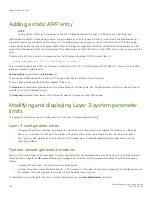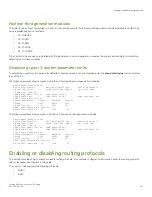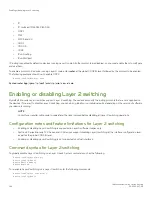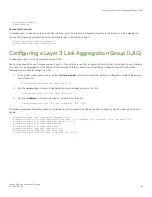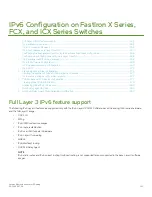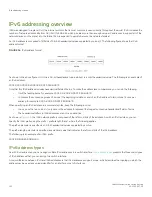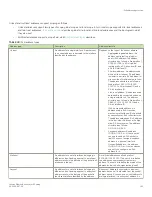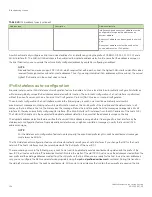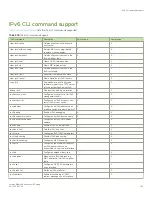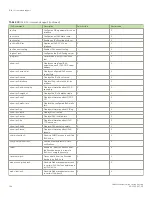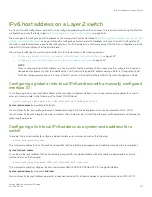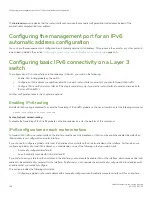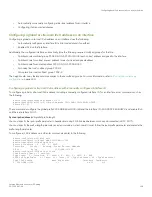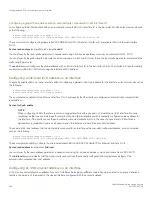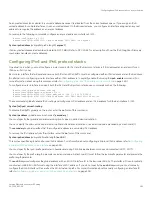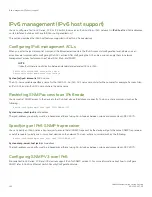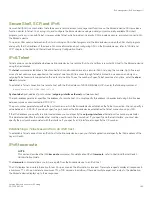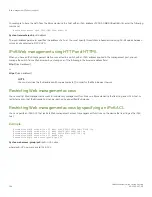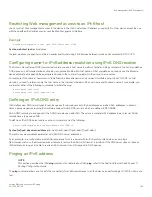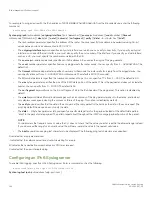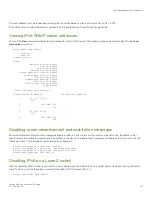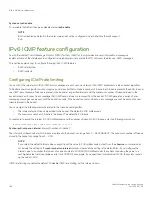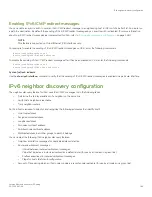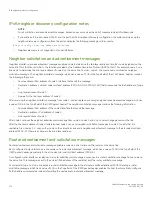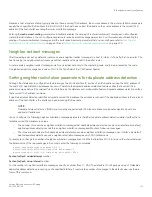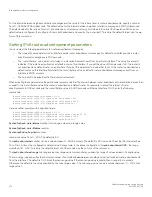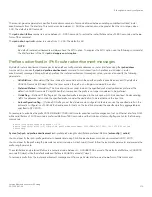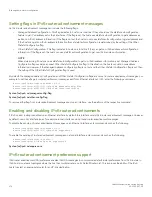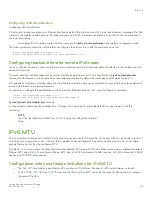
Configuring a global IPv6 address with an automatically computed EUI-64 interface ID
To configure a global IPv6 address with an automatically computed EUI-64 interface ID in the low-order 64-bits, enter commands such
as the following.
device(config)#interface ethernet 1/3/1
device(config-if-e1000-1/3/1)#ipv6 address 2001:DB8:12D:1300::/64 eui-64
These commands configure the global prefix 2001:DB8:12d:1300::/64 and an interface ID, and enable IPv6 on Ethernet interface
1/3/1.
Syntax:
ipv6 address
ipv6-prefix
/
prefix-length
eui-64
You must specify the ipv6-prefix parameter in hexadecimal using 16-bit values between colons as documented in RFC 2373.
You must specify the prefix-length parameter as a decimal value. A slash mark (/) must follow the ipv6-prefix parameter and precede the
prefix-length parameter.
The
eui-64
keyword configures the global address with an EUI-64 interface ID in the low-order 64 bits. The interface ID is automatically
constructed in IEEE EUI-64 format using the interface’s MAC address.
Configuring a link-local IPv6 address on an interface
To explicitly enable IPv6 on a router interface without configuring a global or site-local address for the interface, enter commands such as
the following.
device(config)#interface ethernet 1/3/1
device(config-if-e1000-1/3/1)#ipv6 enable
These commands enable IPv6 on Ethernet interface 1/3/1 and specify that the interface is assigned an automatically computed link-
local address.
Syntax:
[no] ipv6 enable
NOTE
When configuring VLANs that share a common tagged interface with a physical or Virtual Ethernet (VE) interface, Brocade
recommends that you override the automatically computed link-local address with a manually configured unique address for
the interface. If the interface uses the automatically computed address, which in the case of physical and VE interfaces is
derived from a global MAC address, all physical and VE interfaces will have the same MAC address.
To override a link-local address that is automatically computed for an interface with a manually configured address, enter commands
such as the following.
device(config)#interface ethernet 1/3/1
device(config-if-e1000-1/3/1)#ipv6 address FE80::240:D0FF:FE48:4672 link-local
These commands explicitly configure the link-local address FE80::240:D0FF:FE48:4672 for Ethernet interface 1/3/1.
Syntax:
ipv6 address
ipv6-address
link-local
You must specify the ipv6-address parameter in hexadecimal using 16-bit values between colons as documented in RFC 2373.
The
link-local
keyword indicates that the router interface should use the manually configured link-local address instead of the
automatically computed link-local address.
Configuring an IPv6 anycast address on an interface
In IPv6, an anycast address is an address for a set of interfaces belonging to different nodes. Sending a packet to an anycast address
results in the delivery of the packet to the closest interface configured with the anycast address.
Configuring basic IPv6 connectivity on a Layer 3 switch
FastIron Ethernet Switch Layer 3 Routing
160
53-1003627-04
Summary of Contents for FastIron SX 1600
Page 2: ...FastIron Ethernet Switch Layer 3 Routing 2 53 1003627 04 ...
Page 16: ...FastIron Ethernet Switch Layer 3 Routing 16 53 1003627 04 ...
Page 20: ...FastIron Ethernet Switch Layer 3 Routing 20 53 1003627 04 ...
Page 142: ...FastIron Ethernet Switch Layer 3 Routing 142 53 1003627 04 ...
Page 150: ...FastIron Ethernet Switch Layer 3 Routing 150 53 1003627 04 ...
Page 200: ...FastIron Ethernet Switch Layer 3 Routing 200 53 1003627 04 ...
Page 214: ...FastIron Ethernet Switch Layer 3 Routing 214 53 1003627 04 ...
Page 350: ...FastIron Ethernet Switch Layer 3 Routing 350 53 1003627 04 ...
Page 476: ...FastIron Ethernet Switch Layer 3 Routing 476 53 1003627 04 ...
Page 588: ...FastIron Ethernet Switch Layer 3 Routing 588 53 1003627 04 ...

